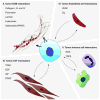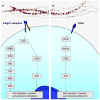Tumor-stromal interactions in pancreatic cancer
- PMID: 23237556
- PMCID: PMC3632415
- DOI: 10.1615/critrevoncog.v18.i1-2.80
Tumor-stromal interactions in pancreatic cancer
Abstract
The tumor associated stroma has been described in recent years as being complicit in tumor growth in pancreatic cancer. The stroma hosts a variety of components of both cellular and molecular makeup. In normal tissues, the stroma provides nutrients and regulatory signals for proper cellular polarity and function. However, following oncogenic transformation, the stromal compartment is conscripted to provide stimulatory signals and protection to tumor cells. It is these tumor-stromal interactions that are currently of great therapeutic interest. Several key reports have suggested that therapeutic targeting of the tumor-stromal interactions in pancreatic cancer has the potential to offer survival benefit. In this review, we will discuss the tumor-stromal interactions that contribute to tumor growth and progression, and ways in which we might counter these interactions.
Figures



Similar articles
-
Reshaping the Tumor Stroma for Treatment of Pancreatic Cancer.Gastroenterology. 2018 Mar;154(4):820-838. doi: 10.1053/j.gastro.2017.11.280. Epub 2017 Dec 26. Gastroenterology. 2018. PMID: 29287624 Review.
-
Pancreatic cancer and its stroma: a conspiracy theory.World J Gastroenterol. 2014 Aug 28;20(32):11216-29. doi: 10.3748/wjg.v20.i32.11216. World J Gastroenterol. 2014. PMID: 25170206 Free PMC article. Review.
-
Imbalance of desmoplastic stromal cell numbers drives aggressive cancer processes.J Pathol. 2013 May;230(1):107-17. doi: 10.1002/path.4172. Epub 2013 Mar 21. J Pathol. 2013. PMID: 23359139 Free PMC article.
-
Interplay of tumor microenvironment cell types with parenchymal cells in pancreatic cancer development and therapeutic implications.J Gastrointest Cancer. 2009;40(1-2):1-9. doi: 10.1007/s12029-009-9071-1. Epub 2009 Jun 10. J Gastrointest Cancer. 2009. PMID: 19513861 Review.
-
Crosstalk between stromal cells and cancer cells in pancreatic cancer: New insights into stromal biology.Cancer Lett. 2017 Apr 28;392:83-93. doi: 10.1016/j.canlet.2017.01.041. Epub 2017 Feb 8. Cancer Lett. 2017. PMID: 28189533 Review.
Cited by
-
SMAD4 loss enables EGF, TGFβ1 and S100A8/A9 induced activation of critical pathways to invasion in human pancreatic adenocarcinoma cells.Oncotarget. 2016 Oct 25;7(43):69927-69944. doi: 10.18632/oncotarget.12068. Oncotarget. 2016. PMID: 27655713 Free PMC article.
-
Extracellular Matrix Collagen I Differentially Regulates the Metabolic Plasticity of Pancreatic Ductal Adenocarcinoma Parenchymal Cell and Cancer Stem Cell.Cancers (Basel). 2023 Jul 29;15(15):3868. doi: 10.3390/cancers15153868. Cancers (Basel). 2023. PMID: 37568684 Free PMC article.
-
3D approaches to model the tumor microenvironment of pancreatic cancer.Theranostics. 2020 Apr 6;10(11):5074-5089. doi: 10.7150/thno.42441. eCollection 2020. Theranostics. 2020. PMID: 32308769 Free PMC article. Review.
-
c-Jun N-terminal kinase inhibitor SP600125 enhances barrier function and elongation of human pancreatic cancer cell line HPAC in a Ca-switch model.Histochem Cell Biol. 2015 May;143(5):471-9. doi: 10.1007/s00418-014-1300-4. Epub 2014 Dec 16. Histochem Cell Biol. 2015. PMID: 25511417
-
Tumor Reduction in Primary and Metastatic Pancreatic Cancer Lesions With nab-Paclitaxel and Gemcitabine: An Exploratory Analysis From a Phase 3 Study.Pancreas. 2017 Feb;46(2):203-208. doi: 10.1097/MPA.0000000000000742. Pancreas. 2017. PMID: 27841795 Free PMC article. Clinical Trial.
References
-
- Paget S. The distribution of secondary growths in cancer of the breast. The Lancet. 1889;133:571–73. - PubMed
-
- Siegel R, Naishadham D, Jemal A. Cancer statistics. CA Cancer J Clin. 2012;62:10–29. - PubMed
-
- Mahadevan D, Von Hoff DD. Tumor-stroma interactions in pancreatic ductal adenocarcinoma. Mol Cancer Ther. 2007;6:1,186–97. - PubMed
-
- Yen TW, Aardal NP, Bronner MP, Thorning DR, Savard CE, Lee SP, Bell RH., Jr Myofibroblasts are responsible for the desmoplastic reaction surrounding human pancreatic carcinomas. Surgery. 2002;131:129–34. - PubMed
-
- Magzoub M, Jin S, Verkman AS. Enhanced macromolecule diffusion deep in tumors after enzymatic digestion of extracellular matrix collagen and its associated proteoglycan decorin. FASEB J. 2008;22:276–84. - PubMed
Publication types
MeSH terms
Grants and funding
LinkOut - more resources
Full Text Sources
Other Literature Sources
Medical

